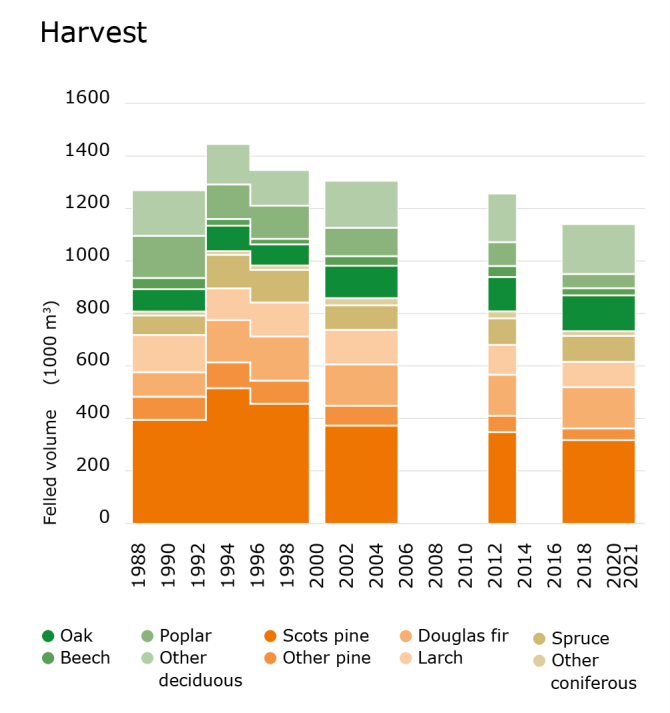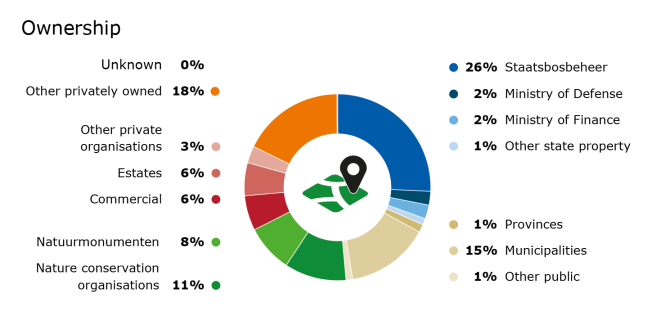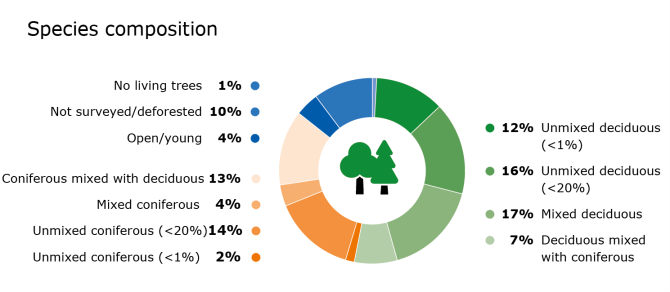
The Dutch National Forest Inventory
Wageningen Environmental Research carries out the Dutch Forest Inventory together with partners on behalf of the Ministry of Agriculture, Nature and Food Quality. The purpose of the Dutch Forest Inventory (NBI) is to get insight on the current condition of the Dutch forest and of developments since the previous inventory.
The NBI mainly focuses on the biomass and (wood) production aspects of the forest. The history of the NBI dates back to 1938, when the first inventory began. Since then, seven inventory censuses have been carried out. NBI's measurement results are important for the Dutch government to comply with international reporting obligations, including carbon sequestration (also known as the United Nations Climate Change Convention) and various international surveys such as the FAO's Forest Resource Assessment (FRA) and Forest Europe (formerly MCPFE). These surveys result in overview reports such as the Global Forest Resource Assessment 2020 and State of Europe's Forests 2020. The research also provides information for interested Dutch parties from the forest and nature sector. Because of these legal obligations, the NBI is part of the WOT Nature & Environment.
Since the start of the NBI-7 in 2017, the NBI has been conducted on a 5-year cycle. The NBI-7 has been completed in 2022, the report can be downloaded here. The database with the measurement data can be downloaded from the Probos website. The NBI-8 has starteds immediately afterwards and will run until 2026. The LULUCF and LGN maps were used to determine the more than 3,500 regular sample points in the NBI-8. In addition, approximately 120 additional sample points have been deployed in forests with habitat types that are poorly represented in the regular inventory. A vegetation survey is also carried out at these points. Together with information from the regular inventory, this will be reported to the Habitat Directive reporting in 2025. A soil profile description will be made once by a field soil scientist at the entire set of sample points during the NBI-8.
Results
The results below are based on the NBI-7. When the NBI-8 is completed in 2026, the new results will be published here.
Surface
Ownership
Species composition
Age
The Dutch forest is ageing since the Second World War and the number of large trees is increasing. Coniferous forest is now on average 71 years old, while deciduous forest is on average 60 years old. Young forest (<20 years old) has decreased compared to the first forest inventory in 1938-1942 from almost 40% to 9% now.
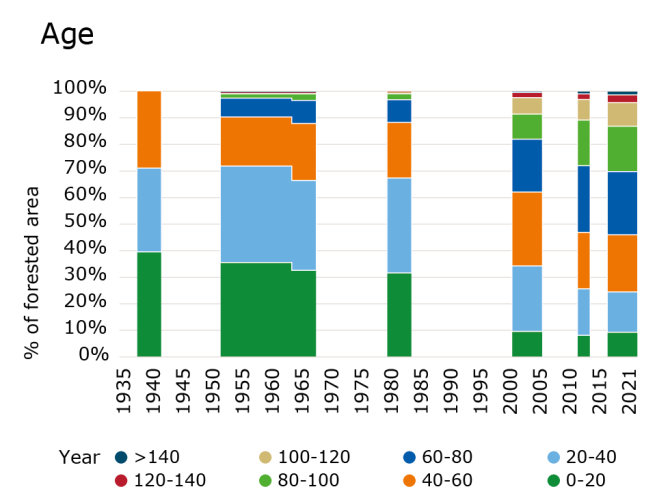
Regeneration
The amount of natural regeneration (trees with a diameter at breast height <5 cm, but with a height >50 cm) has also been estimated in the NBI-7. On the majority of the plots there was only regeneration of deciduous tree species, while only on 6% of the plots the regeneration consisted solely of coniferous species. It was striking that black cherry (Prunus serotina) was found on more than one third of all plots.

Standing stock
The standing stock of wood has increased from 198 m3/ha in 2001-2005 to 224 m3/ha in the NBI-7. Standing dead wood has increased from 4,6 to 10,0 m3/ha and lying dead wood has increased from 5,4 to 9,2 m3/ha. The share of almost all coniferous species has decreased in the growing stock, causing coniferous species to account for 46% of the growing stock now, compared to 55% in the MFV. An exception to the increase in deciduous trees is ash, which is declining.
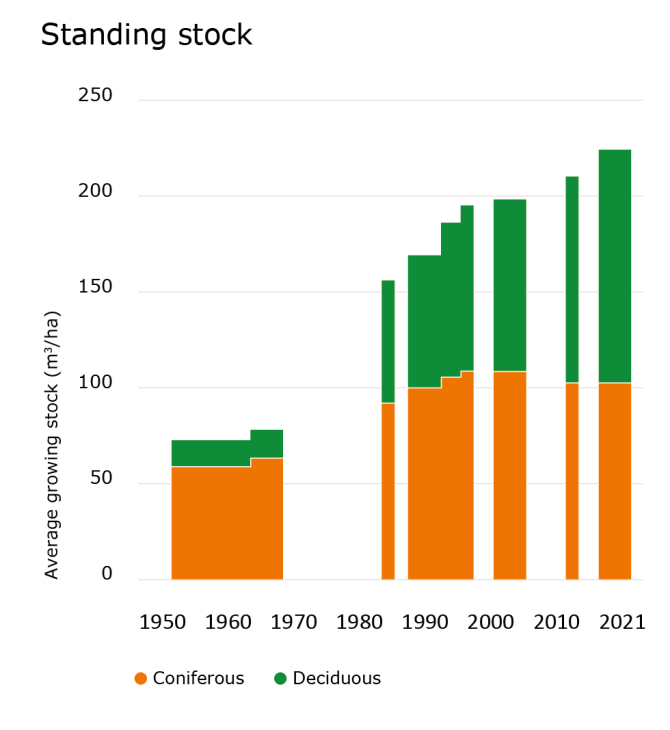
Increment
The average increment has decreased slightly, from 7,2 m3 ha-1 yr-1 in NBI-6 to 6,6 m3 ha-1 yr-1 in NBI-7. The decline in Douglas fir and ash is particularly notable. Douglas fir probably suffered from drought stress, while in ash it is a direct result of ash dieback disease. Other conifer species also seem to suffer from drought, because in coniferous forest increment decreased from 8,1 m3 ha-1 yr-1in NBI-6 to 7,0 m3 ha-1 yr-1 in NBI-7.
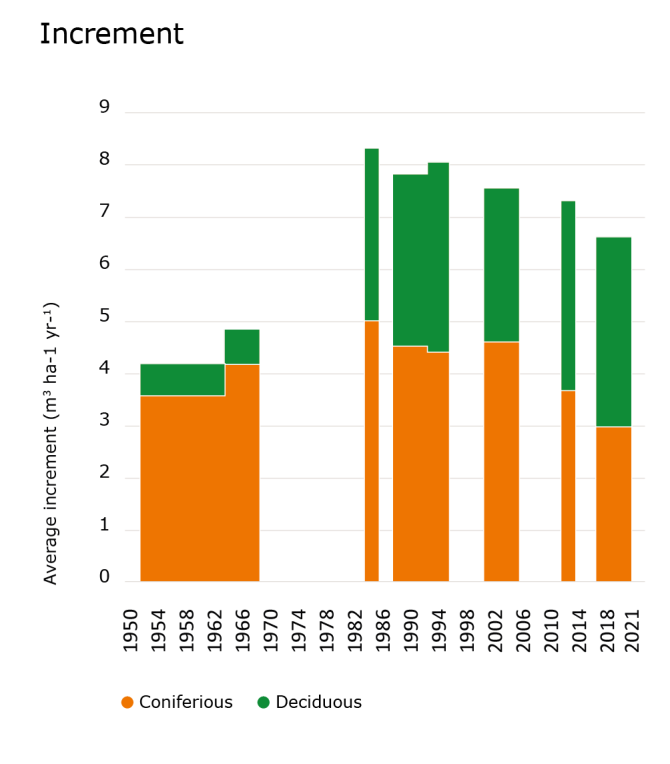
Harvest
An estimated 1.15 million m3 of wood is felled annually (from 3.4 m3 ha-1 yr-1 in NBI-6 to m3 ha-1 yr-1 in NBI-7). Of this, roughly two-thirds is felled in coniferous forests and one-third in deciduous forests. In general, deciduous tree species have a lower share in felling than would be expected based on their share in both basal area and increment. The opposite applies to coniferous tree species.
